Improvement of Shape Error for Slender Parts in Cylindrical Traverse Grinding by Part-Deformation Modelling and Compensation
Abstract
1. Introduction
2. Theoretical Approach
3. Results
3.1. Validation of the Theoretical Approach
3.1.1. Validation of the Deformation Prediction Approach with Steady Rests
3.1.2. Experimental Validation of the Theoretical Approach
- KTailstock = 74 N/µm;
- KHeadstock = 50 N/µm;
3.2. Solution for the Shape Error
4. Conclusions
- First, a new prediction model for characterizing the deformation of the slender workpiece was presented, updating previous models by including a distributed load (corresponding to the grinding wheel width) and the capacity to use different steady rests. Second, validation of the analytical model was achieved by comparison with FEM, with high accuracy. The difference between analytical model prediction and FEM was 2.7%. In future analyses, this will be validated in a real process.
- A procedure to experimentally obtain the stiffness of the headstock and the tailstock was presented. The addition of this input to the model was necessary to achieve a good correlation between theoretical and experimental results.
- The accuracy of the shape error prediction model was validated experimentally by comparing this with the measured diameters. Differences in results between theoretical and experimental approaches were below 5%.
- A solution for improving the shape error in the slender workpiece in the traverse cycle was presented, reducing the shape error by 77% without the need to include steady rests in the solution, as in previous proposals. Moreover, the number of spark-out strokes could be reduced by applying cross-compensation. This could considerably reduce the cycle time.
- The automation of shape-error correction was simplified by using the model output (shape error defined by the normal force) and cross-compensation cycle. The main reason for the simplicity of the solution for the shape error was that the only input needed for the model was the normal force, which was easily measurable by the Servotrace acquisition system of the Siemens CNC.
- Workpiece geometric measurements from the nominal and compensated roughing and finishing cycles were presented, so an overall analysis of the influence of the solution in the grinding process was performed. Cylindricity and straightness decreased, as expected, in a similar fashion to shape error, while roundness remained stable. Thus, it is feasible to integrate this solution into real processes to improve geometrical characteristics of the workpiece.
Author Contributions
Funding
Data Availability Statement
Conflicts of Interest
References
- Kruszynski, B.W.; Lajmert, P. An Intelligent Supervision System for Cylindrical Traverse Grinding. CIRP Ann. 2005, 54, 305–308. [Google Scholar] [CrossRef]
- Alvarez, J.; Zatarain, M.; Marquinez, J.I.; Ortega, N.; Gallego, I. Avoiding Chatter in Traverse Cylindrical Grinding by Continuous Workpiece Speed Variation. ASME J. Manuf. Sci. Eng. 2013, 135, 051011. [Google Scholar] [CrossRef]
- Shimizu, T.; Inagaki, I.; Yonetsu, S. Regenerative Chatter during Cylindrical Traverse Grinding. Bull. JSME 1978, 21, 317–323. [Google Scholar] [CrossRef][Green Version]
- Cropping, L.; Grossi, N.; Scipa, A.; Campatelli, G. Fixture Optimization in Turning Thin-Wall Components. Machines 2019, 7, 68. [Google Scholar] [CrossRef]
- Park, C.W.; Kim, D.E.; Lee, S.J. Shape prediction during the cylindrical traverse grinding of a slender workpiece. J. Mater. Process. Technol. 1999, 88, 23–32. [Google Scholar] [CrossRef]
- Onishi, T.; Kodani, T.; Ohashi, K.; Sakakura, M.; Tsukamoto, S. Study on the Shape Error in the Cylindrical Traverse Grinding of a Workpiece with High Aspect Ratio. Adv. Mater. Res. 2014, 1071, 78–81. [Google Scholar] [CrossRef]
- Sakamoto, K.; Onishi, T.; Sakakura, M.; Kawaguchi, N.; Ohashi, K. Estimation of the shape error in the long workpiece from the normal grinding force of cylindrical traverse grinding. In Proceedings of the 21st International Symposium on Advances in Abrasive Technology, ISAAT 2018, Toronto, ON, Canada, 14–16 October 2018. [Google Scholar]
- Wang, J.; Feng, P.; Zha, T. Process monitoring in precision cylindrical traverse grinding of slender bar using acoustic emission technology. J. Mech. Sci. Technol. 2017, 31, 859–864. [Google Scholar] [CrossRef]
- Jianliang, G.; Rong, H. A united model of diametral error in slender bar turning with a follower rest. Int. J. Mach. Tools Manuf. 2006, 46, 1002–1012. [Google Scholar] [CrossRef]
- Gao, Y.; Foster, K. Computer simulation of the deformation of slender multi-diameter rollers during grinding. Int. J. Mach. Tools Manuf. 1991, 31, 83–93. [Google Scholar] [CrossRef]
- Tsagkir Dereli, T.; Schmidt, N.; Furlan, T.; Holtermann, R.; Biermann, D.; Menzel, A. Simulation Based Prediction of Compliance Induced Shape Deviations in Internal Traverse Grinding. J. Manuf. Mater. Process. 2021, 5, 60. [Google Scholar] [CrossRef]
- Mehta, P.; Mears, L. Model-based Prediction and Control of Machining Deflection Error in Turning Slender Bars. ASME J. Manuf. Sci. Eng. 2011, 2, 263–271. [Google Scholar] [CrossRef]
- Ding, N.; Wang, L.S.; Li, G.F.; Meng, F.Y.; Chen, D.M. Intelligent Optimization Control of Workpiece Deformation for Traverse Grinding. Key Eng. Mater. 2004, 259–260, 333–337. [Google Scholar] [CrossRef]
- Fujii, H.; Onishi, T.; Lin, C.; Sakakura, M.; Ohashi, K. Improvement of form accuracy in cylindrical traverse grinding with steady rest by controlling traverse speed. J. Adv. Mech. Des. Sys. Manuf. 2021, 15, 20–00505. [Google Scholar] [CrossRef]
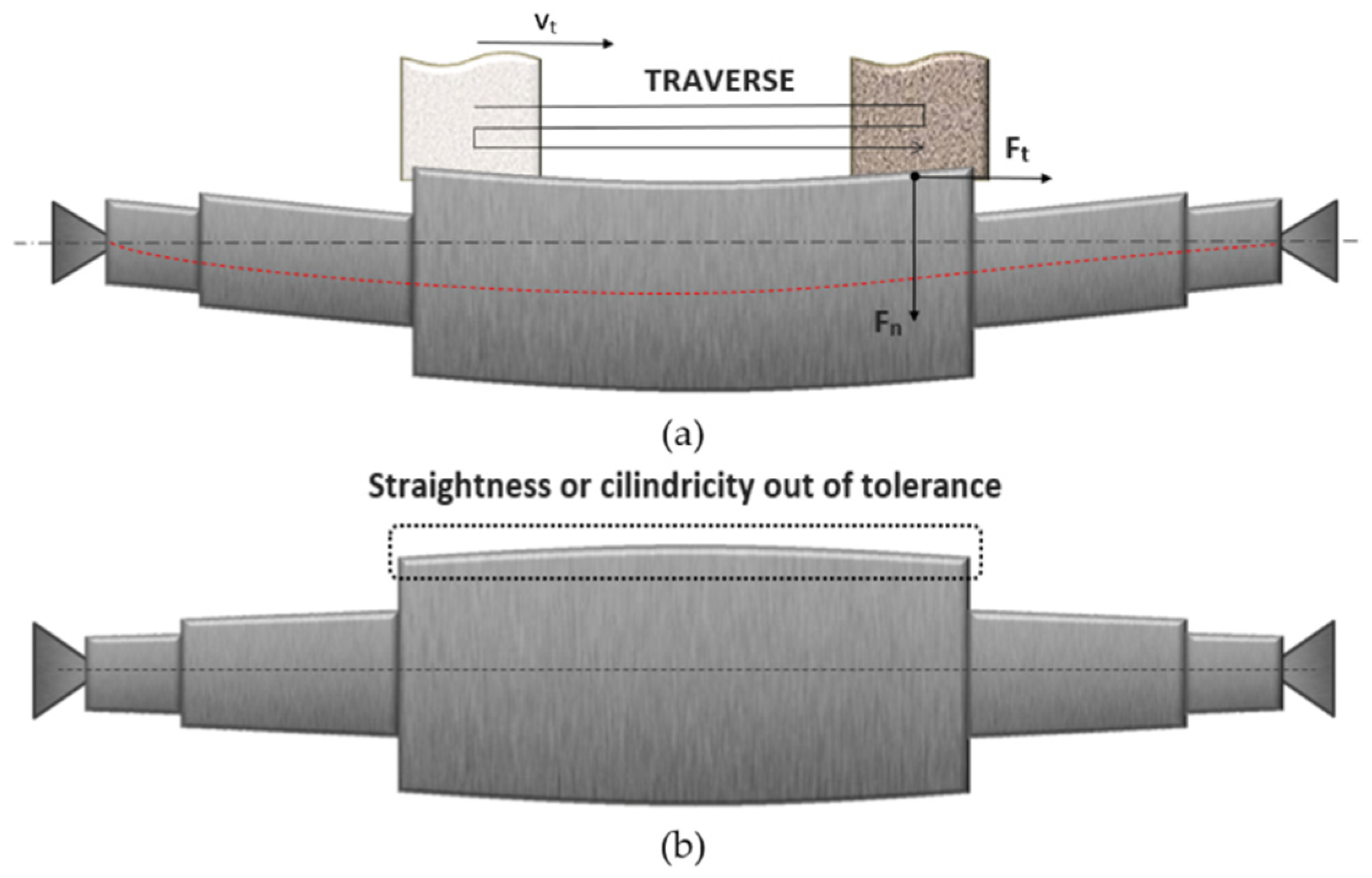
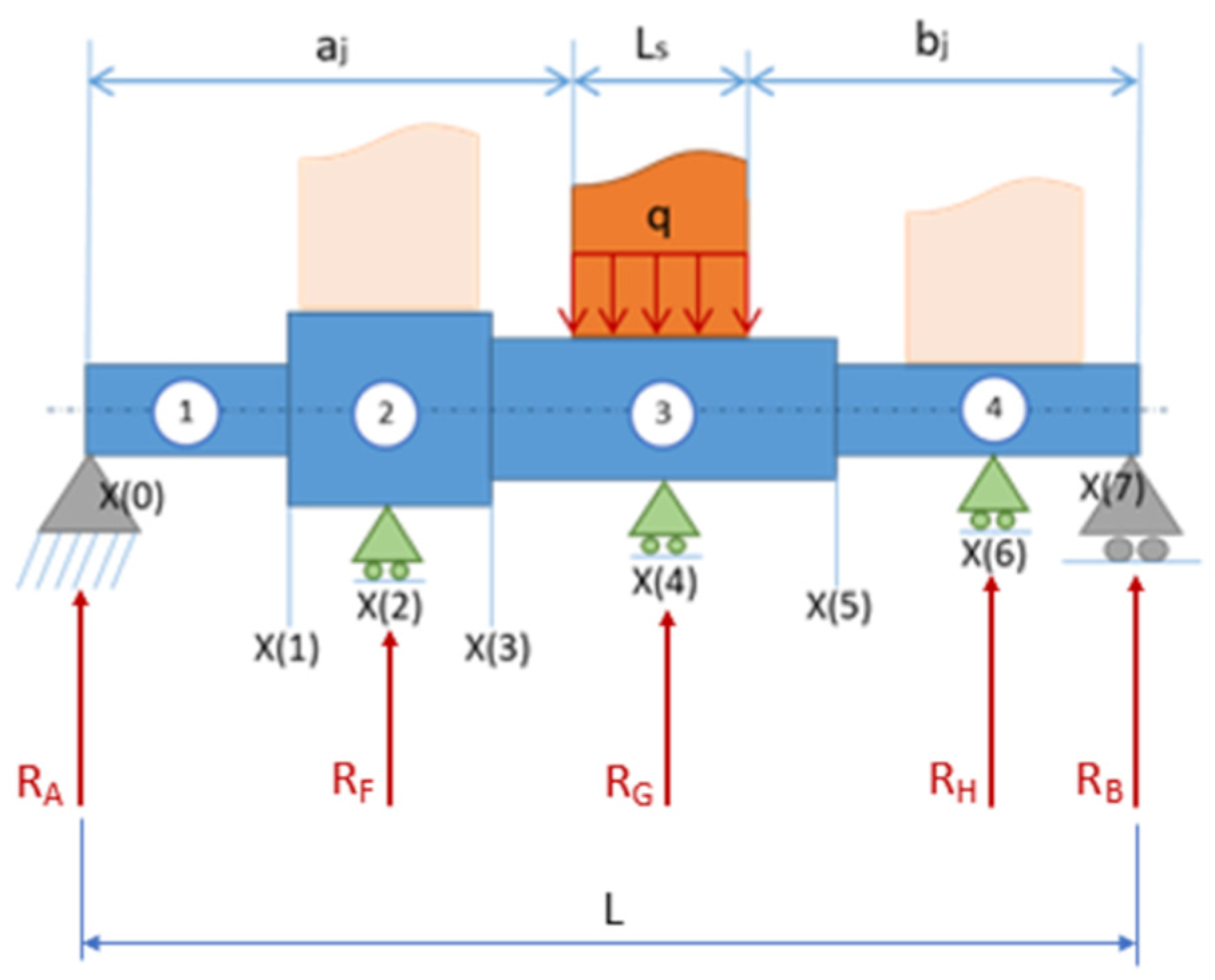
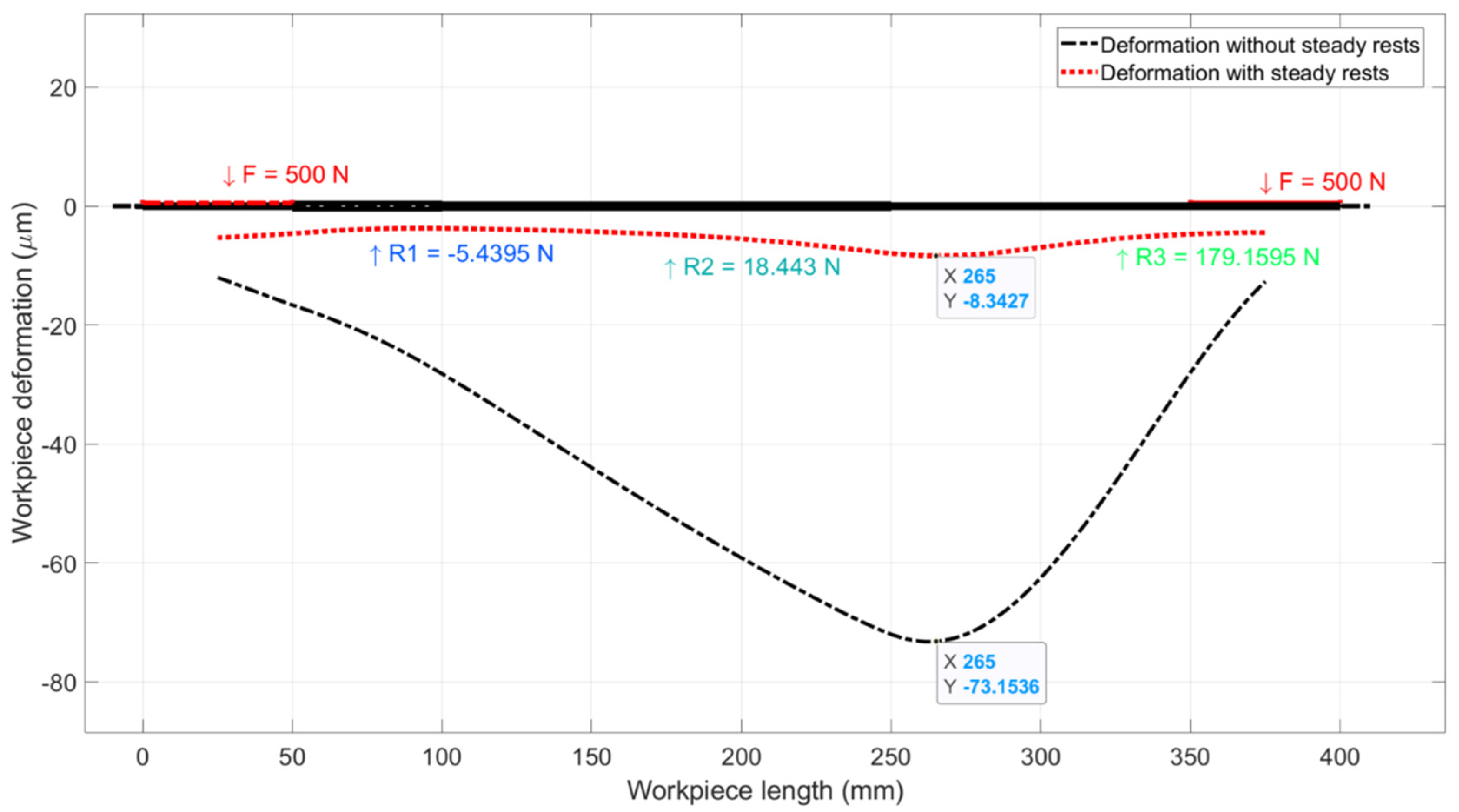
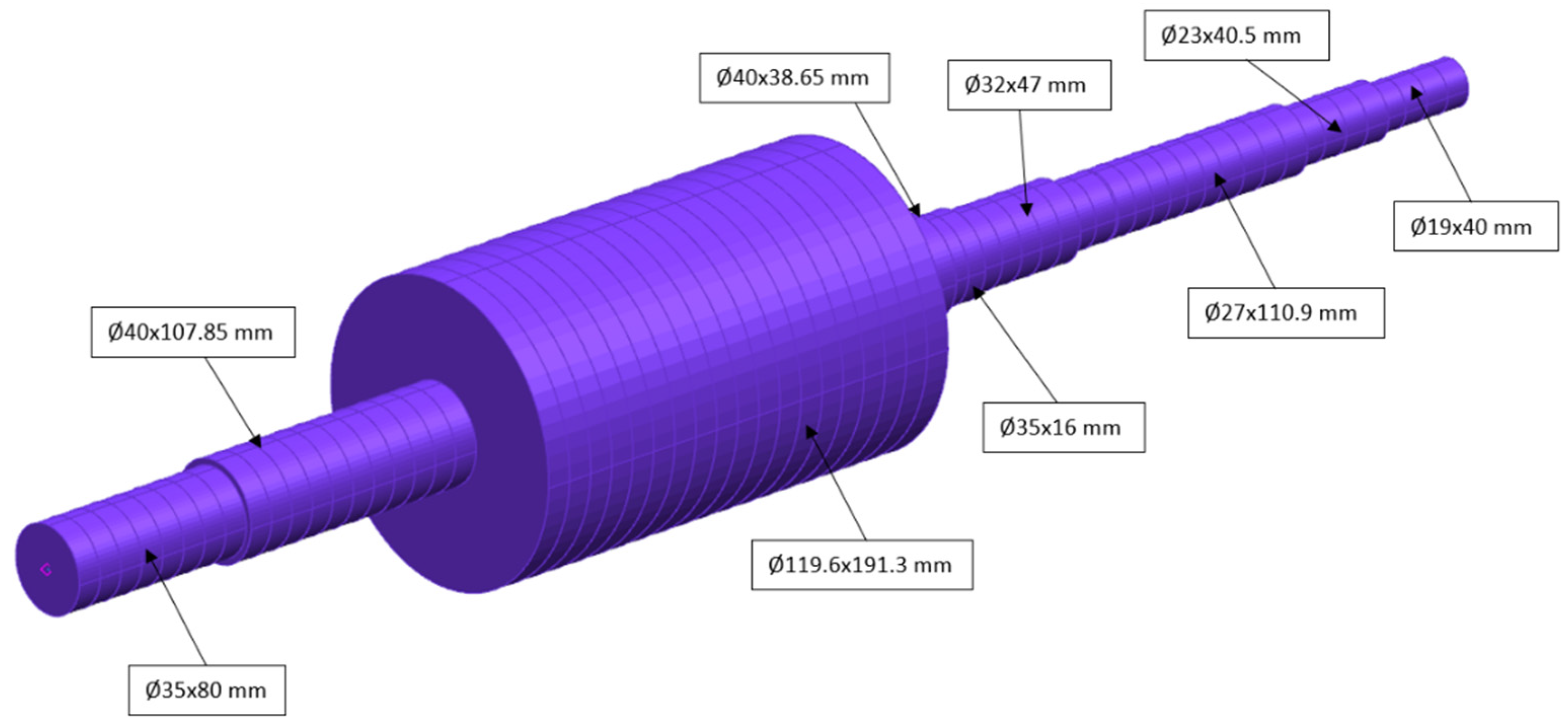
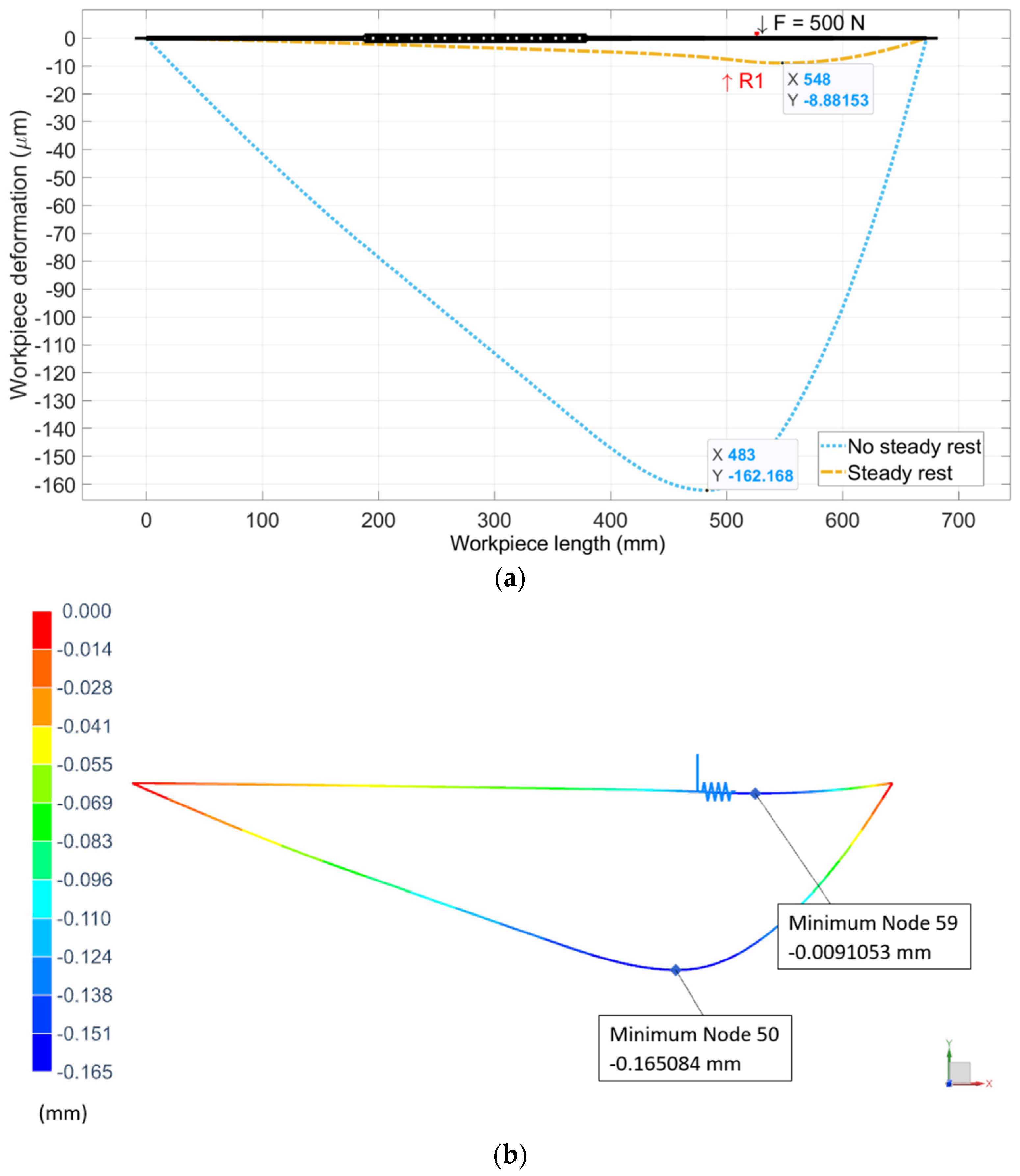
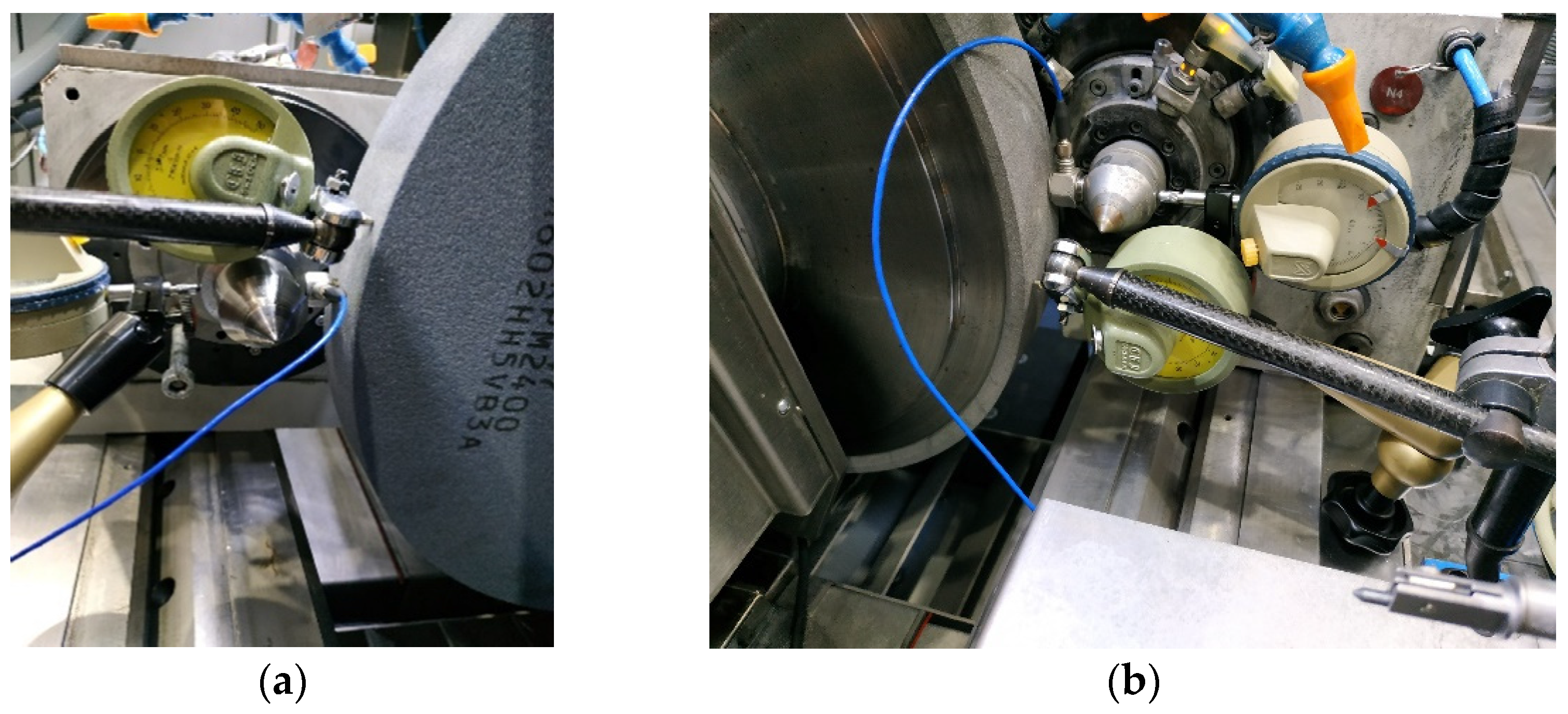
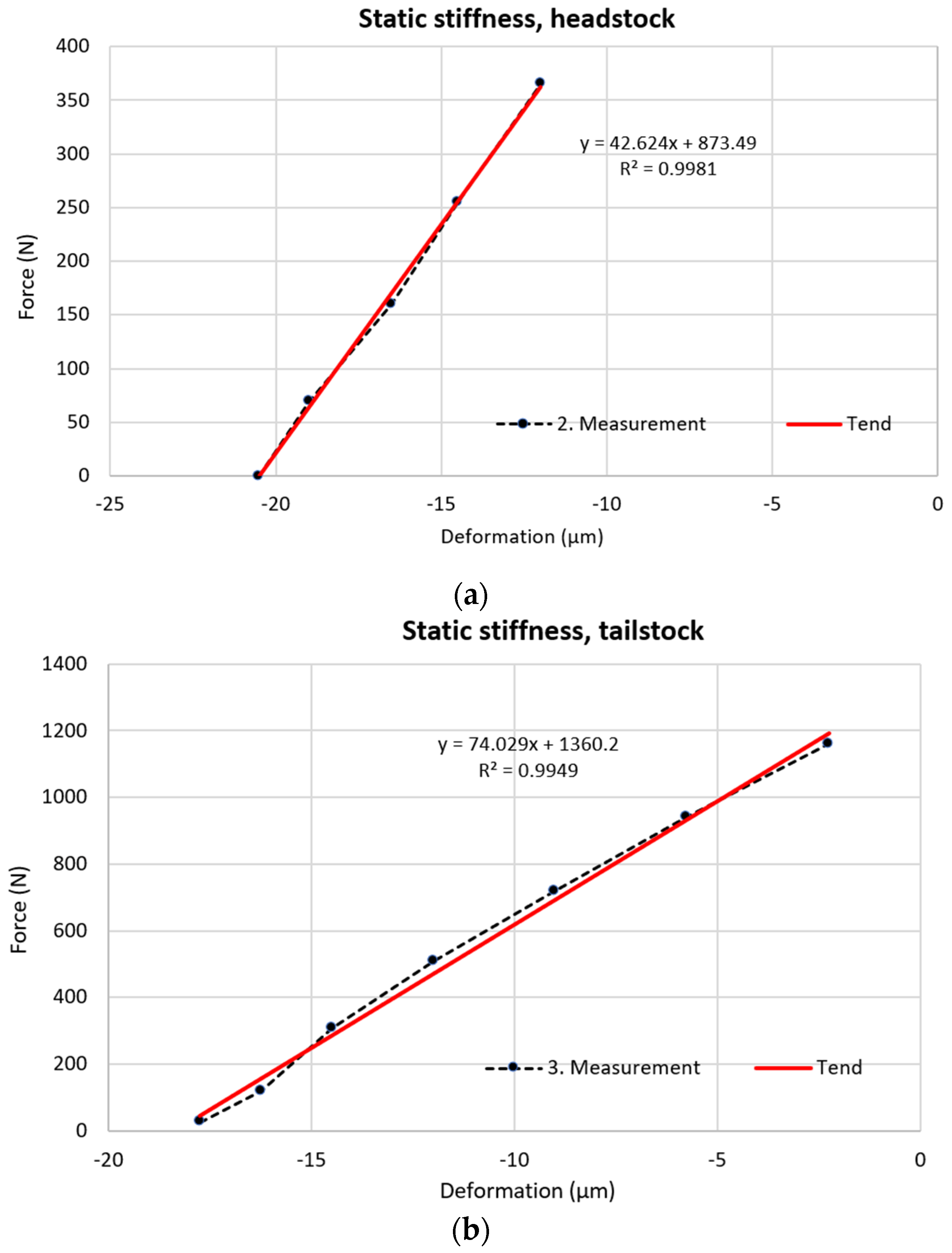
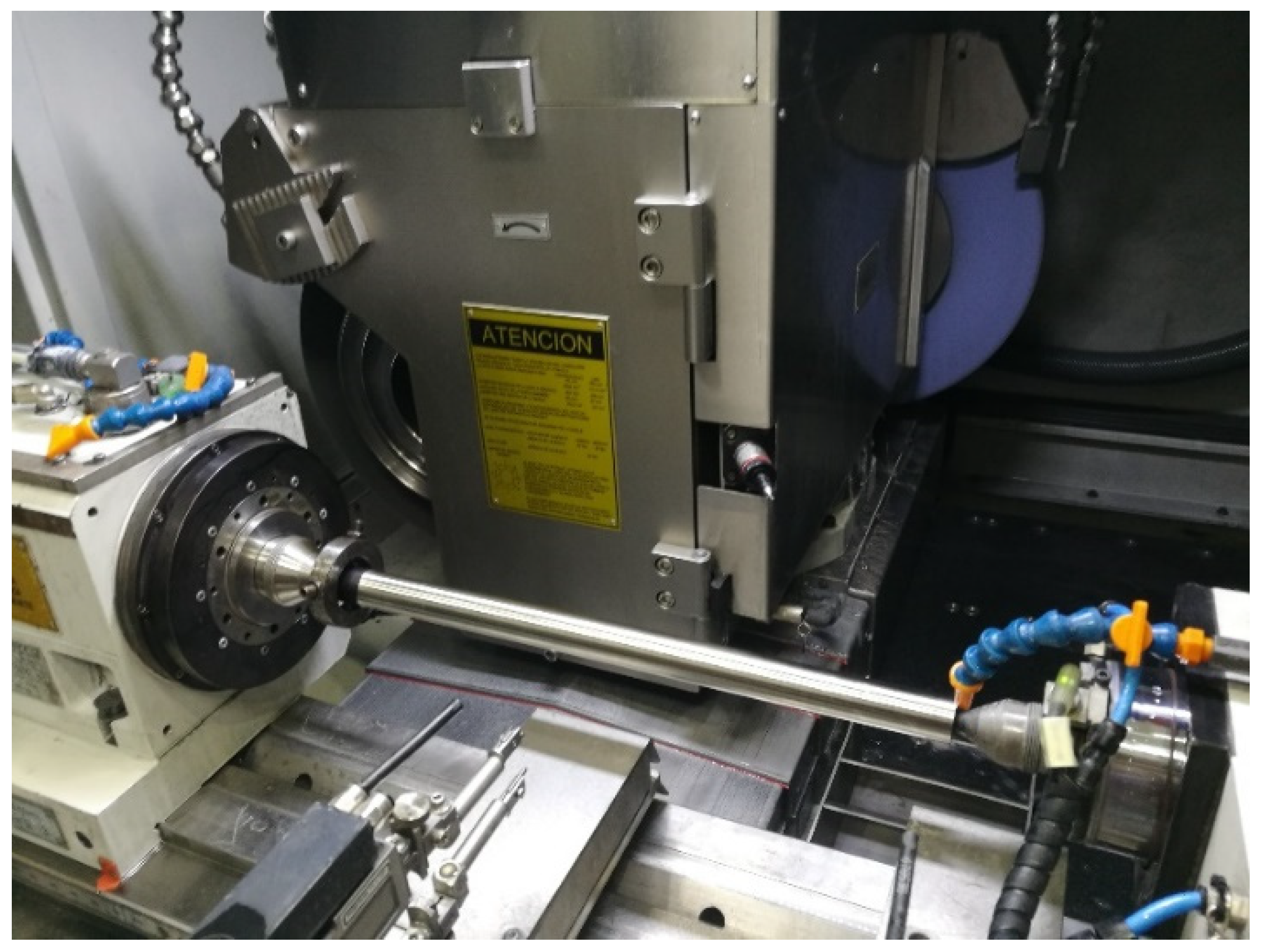

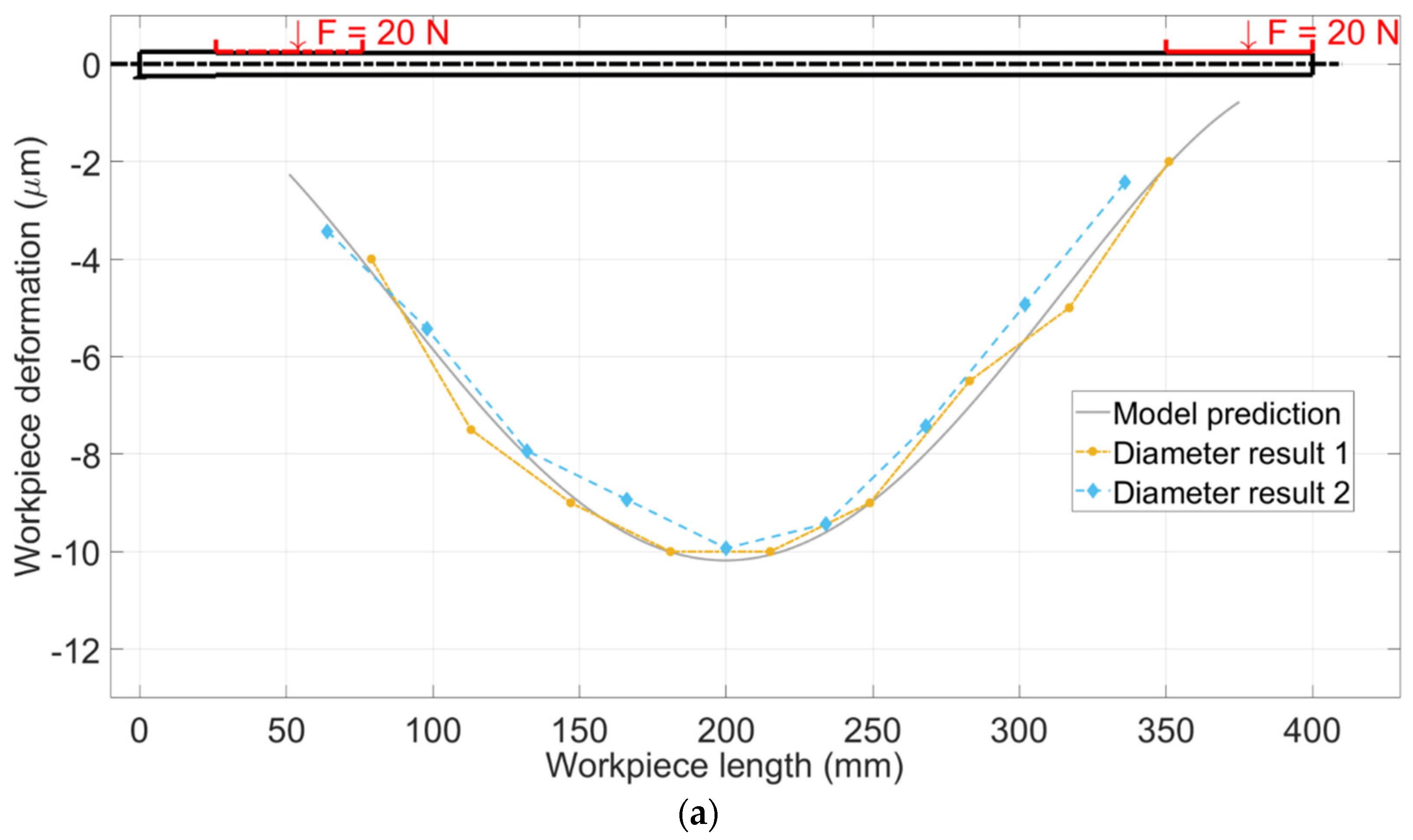
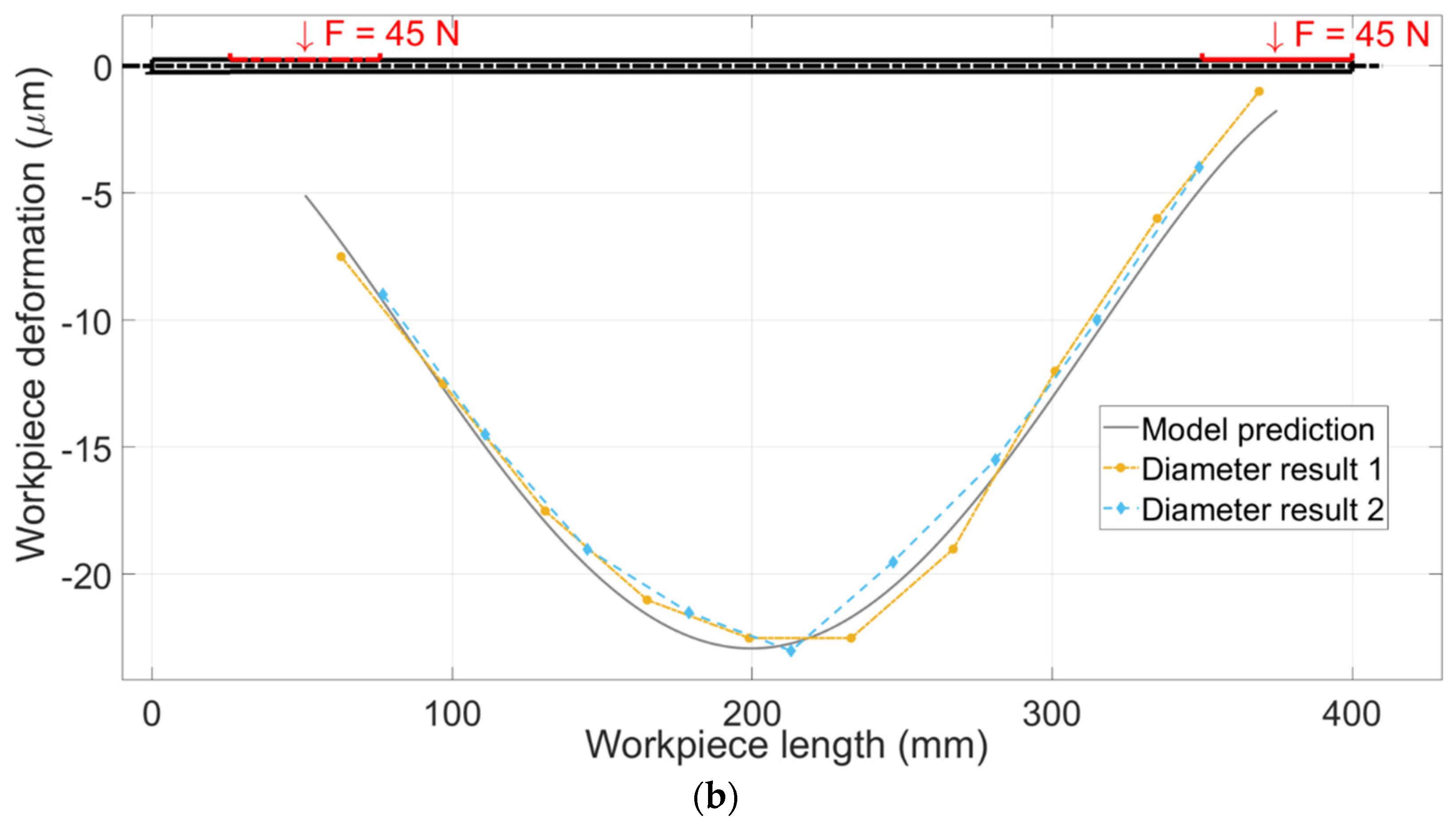
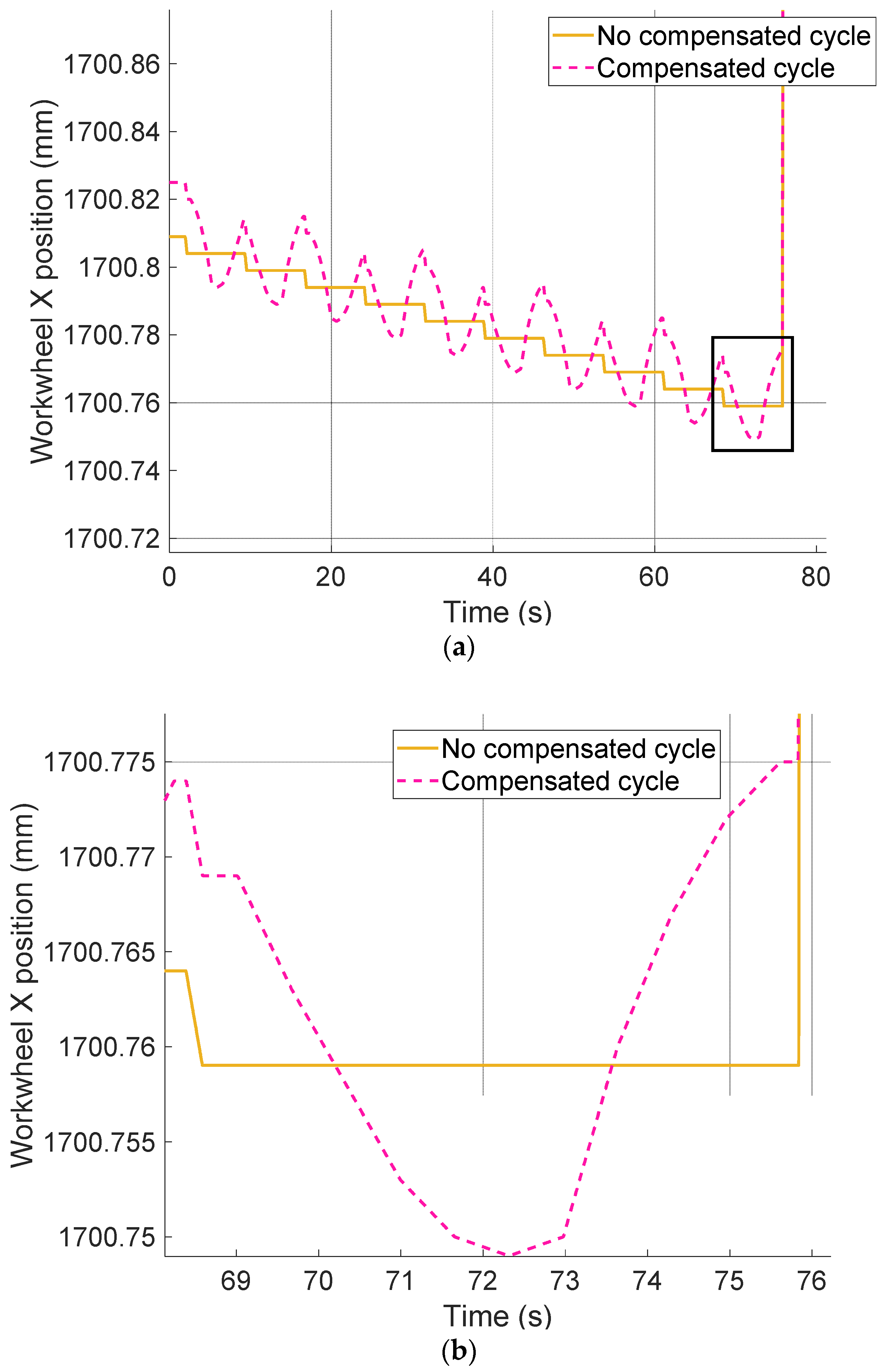
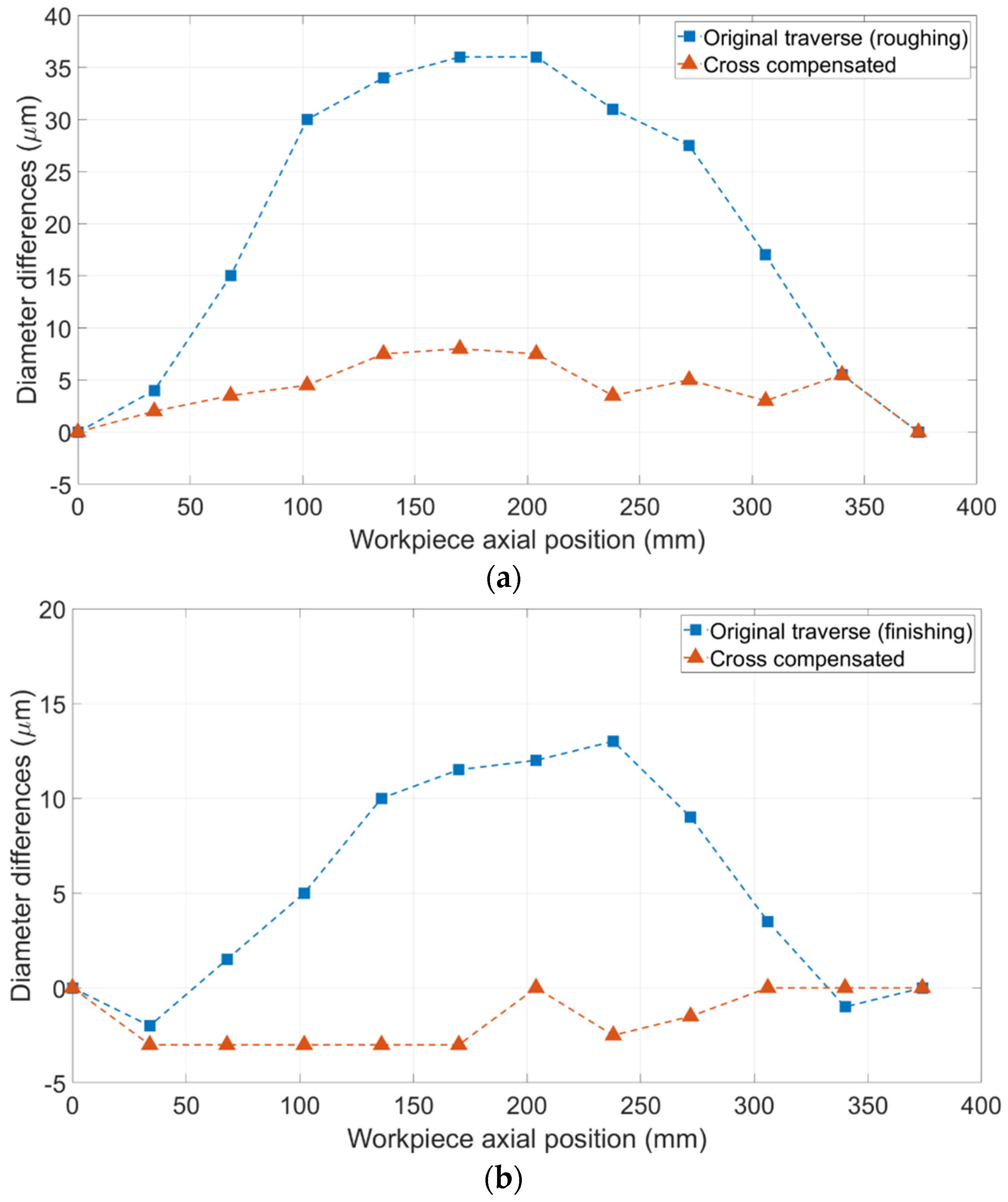
| Workpiece density (Kg/m3) | 7850 (steel) |
| Workpiece Young modulus (GPa) | 210 (steel) |
| Workpiece diameters (mm) | 25, 50, 40 and 25 mm |
| Workpiece lengths (mm) | 50, 50, 150 and 150 mm |
| Distributed load (N) | 500 N applied in 400 mm |
| Wheel width (mm) | 50 |
| Supports stiffness (N/µm) | 54–32 |
| Steady rest stiffness (N/µm) | 60 applied in 75, 175 and 325 mm |
| Density (Kg/m3) | 7850 (steel) |
| Young modulus (GPa) | 210 (steel) |
| Distributed load | 500 N applied in 526 mm |
| Wheel width (mm) | 50 |
| Supports stiffness (N/µm) | 54–32 |
| Steady rest stiffness (N/µm) | 60 applied in 500 mm |
| No Steady Rest | With Steady Rest | |
|---|---|---|
| Analytical | 162.2 µm | 8.9 µm |
| FEM | 165 µm | 9.1 µm |
| Difference | 1.7% | 2.1% |
| Grinding machine | Danobat LG600 B6 |
| Wheel specifications | CS65A 60.2 HH5 VB3 |
| Wheel dimensions (mm) | 475 × 50 × 50.2 |
| Workpiece material | Hardened F5520 (53 HRC) |
| Workpiece dimensions (mm) | Ø25 × 400 |
| Grinding fluid | Castrol 75EF coolant (4%) |
| Tailstock pressure (bar) | 5 |
| Grinding Conditions | Roughing | Finishing |
|---|---|---|
| Cutting speed (m/s) | 60 | 60 |
| Part rotational speed (RPM) | 171 | 161 |
| Stock Ø (mm) | 0.05 | 0.02 |
| Traverse speed (mm/min) | 3000 | 1318 |
| Grinding pass (mm) | 0.01 | 0.002 |
| Spark-out strokes | 0 | 0 |
| Infeed position | Both sides | Both sides |
| Dressing conditions | ||
| Cutting speed (m/s) | 60 | |
| Feed rate (mm/min) | 241 | |
| Dressing pass (mm) | 0.015 | |
| Strokes | 2 | |
| Condition | Roughing | Finishing |
|---|---|---|
| Average error (µm) | 0.969 | 0.404 |
| Deviation (µm) | 1.724 | 0.472 |
| Condition | Non-Compensated Maximum Error (µm) | Compensated Maximum Error (µm) | Improvement Percentage (%) |
|---|---|---|---|
| Roughing | 36 | 8 | 77.8% |
| Finishing | 13 | 3 | 76.9% |
| Condition | Compensation | g (µm) | e (µm) | Straightness (µm) |
| Finishing | Nominal (no compensation) | 9.98 | 0.59 | 9.06 |
| condition | Compensated | 6.95 | 0.63 | 1.82 |
| Roughing | Nominal (no compensation) | 20.43 | 1.15 | 19.01 |
| condition | Compensated | 11.68 | 0.94 | 7.57 |
Publisher’s Note: MDPI stays neutral with regard to jurisdictional claims in published maps and institutional affiliations. |
© 2021 by the authors. Licensee MDPI, Basel, Switzerland. This article is an open access article distributed under the terms and conditions of the Creative Commons Attribution (CC BY) license (https://creativecommons.org/licenses/by/4.0/).
Share and Cite
Mendez, I.; Alvarez, J.; Barrenetxea, D.; Godino, L. Improvement of Shape Error for Slender Parts in Cylindrical Traverse Grinding by Part-Deformation Modelling and Compensation. Metals 2021, 11, 1990. https://doi.org/10.3390/met11121990
Mendez I, Alvarez J, Barrenetxea D, Godino L. Improvement of Shape Error for Slender Parts in Cylindrical Traverse Grinding by Part-Deformation Modelling and Compensation. Metals. 2021; 11(12):1990. https://doi.org/10.3390/met11121990
Chicago/Turabian StyleMendez, Ivan, Jorge Alvarez, David Barrenetxea, and Leire Godino. 2021. "Improvement of Shape Error for Slender Parts in Cylindrical Traverse Grinding by Part-Deformation Modelling and Compensation" Metals 11, no. 12: 1990. https://doi.org/10.3390/met11121990
APA StyleMendez, I., Alvarez, J., Barrenetxea, D., & Godino, L. (2021). Improvement of Shape Error for Slender Parts in Cylindrical Traverse Grinding by Part-Deformation Modelling and Compensation. Metals, 11(12), 1990. https://doi.org/10.3390/met11121990







